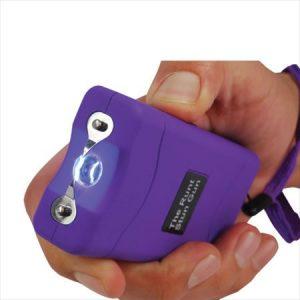Table of Contents
- Choosing the Right Charger for Your Stun Gun Battery
- Preparing Your Stun Gun for Safe and Effective Charging
- Step-by-Step Charging Process to Maximize Battery Life
- Common Charging Mistakes and How to Avoid Them
- Wrapping Up
Choosing the Right Charger for Your Stun Gun Battery
When it comes to powering your stun gun, selecting a charger that matches the battery specifications is crucial for both safety and longevity. Avoid generic chargers; instead, opt for those specifically designed for your stun gun model or compatible battery type. Chargers that offer overcharge protection and temperature regulation help prevent damage caused by overheating or excessive current flow. Additionally, ensure the charger’s voltage and amperage align perfectly with your battery’s requirements to maintain optimal charging efficiency and prevent premature battery wear.
Choosing from chargers with easy-to-read LED indicators or smart charging technology can simplify the charging process, providing real-time feedback on charging status and automatically stopping when the battery is full. Here are a few tips to keep in mind:
- Verify compatibility: Check the manual for compatible chargers and avoid cross-using chargers between different devices.
- Prioritize safety features: Look for chargers that include short-circuit protection and surge control.
- Consider convenience: Models with USB charging options or compact designs can be ideal for on-the-go use.
Preparing Your Stun Gun for Safe and Effective Charging
Before plugging in your stun gun for charging, taking a few preparatory steps can enhance both safety and battery longevity. First, ensure the stun gun is switched off completely-never attempt to charge it while powered on, as this can lead to accidental discharge or damage to the internal circuitry. Next, inspect the charging port and cable for any signs of wear or debris; a clean connection ensures efficient energy transfer and prevents short circuits. If your stun gun comes with a protective safety cover for the charging port, make sure to remove it gently to avoid any damage.
It’s also crucial to place the stun gun on a non-conductive surface, such as a wooden or plastic table, away from moisture and direct sunlight during charging. Avoid charging near flammable materials or high-traffic areas to minimize risks. To optimize battery health, use only the charger manufacturer-approved for your specific model-universal or counterfeit chargers may deliver inconsistent voltage or current. Remember these key points:
- Power off the stun gun fully before charging
- Check and clean charging contacts
- Use the original or certified charger
- Charge on a dry, stable, non-conductive surface
- Avoid exposure to extreme temperatures during charging
Step-by-Step Charging Process to Maximize Battery Life
Begin by fully discharging your stun gun’s battery before the initial charge to calibrate the battery meter accurately. After that, connect your device to the charger using the original cable provided by the manufacturer. Plug it into a low-power USB adapter or charging port to ensure a steady and safe current flow. It’s important to allow the battery to charge uninterrupted until the indicator shows 100%, avoiding partial charges that may reduce the battery’s overall capacity over time. During charging, keep the stun gun in a cool, dry place, away from direct sunlight or heat sources to prevent overheating.
Once fully charged, unplug the device and use it normally until the next recommended recharge threshold – typically between 10-20% battery life remaining. Establishing a routine of charging your stun gun only when necessary helps reduce stress on the battery cells. Also, avoid leaving the stun gun plugged in overnight or for extended periods once it reaches full charge, as this can cause overcharging and degrade battery lifespan. For long-term storage, ensure the battery is around 50% charged to maintain its health, and perform a charge cycle every few months.
- Use manufacturer-approved chargers only.
- Charge in a well-ventilated area.
- Avoid extreme temperatures during charging.
- Disconnect promptly after full charge.
Common Charging Mistakes and How to Avoid Them
One of the most frequent errors users make is overcharging the battery. Leaving your stun gun plugged in beyond the recommended charging time can degrade the battery’s overall lifespan, leading to diminished performance. Another pitfall is using incompatible chargers or cables. Even slight variations in voltage or current can cause damage, so always utilize the manufacturer-supplied charger or a certified equivalent. Additionally, charging in extreme temperatures – either too hot or too cold – can negatively affect battery health, reducing its efficiency and longevity.
Many also overlook the importance of regular maintenance charging; batteries that sit unused for long periods without a charge can develop issues like sulfation or capacity loss. Skipping the charging cycles recommended by your device’s manual can eventually leave you with a stun gun that’s unreliable when you need it most. To avoid common pitfalls, consider these quick tips:
- Always charge in a dry, temperate environment
- Disconnect once the battery reaches full charge
- Store the device with a partial charge if unused for extended periods
- Regularly inspect charging cables for wear or damage
Wrapping Up
Properly charging your stun gun battery is essential to ensure it performs reliably when you need it most. By following the charging guidelines outlined in this guide, you can extend the life of your device and maintain its readiness for self-defense. Remember to always use the charger provided by the manufacturer and avoid overcharging to preserve battery health. With the right care and attention, your stun gun will stay fully charged and ready to protect you whenever necessary. Stay safe and stay prepared!Check Our Other Blogs
- StunGun – Your Trusted Source for Stun Guns, Laws, and Self-Defense Tips
- PepperSprayLaws – Your Trusted Resource for Pepper Spray Information
- StunGunLaws – Your Trusted Guide to Stun Gun Legality and Safety





